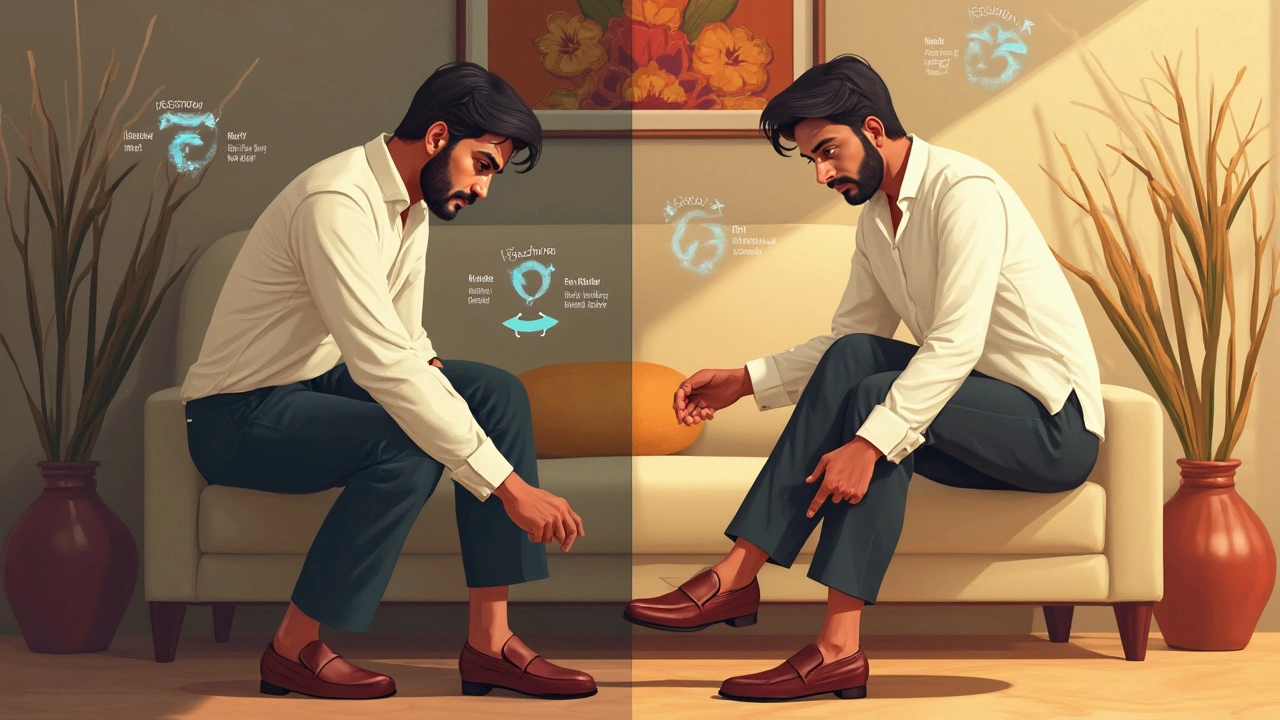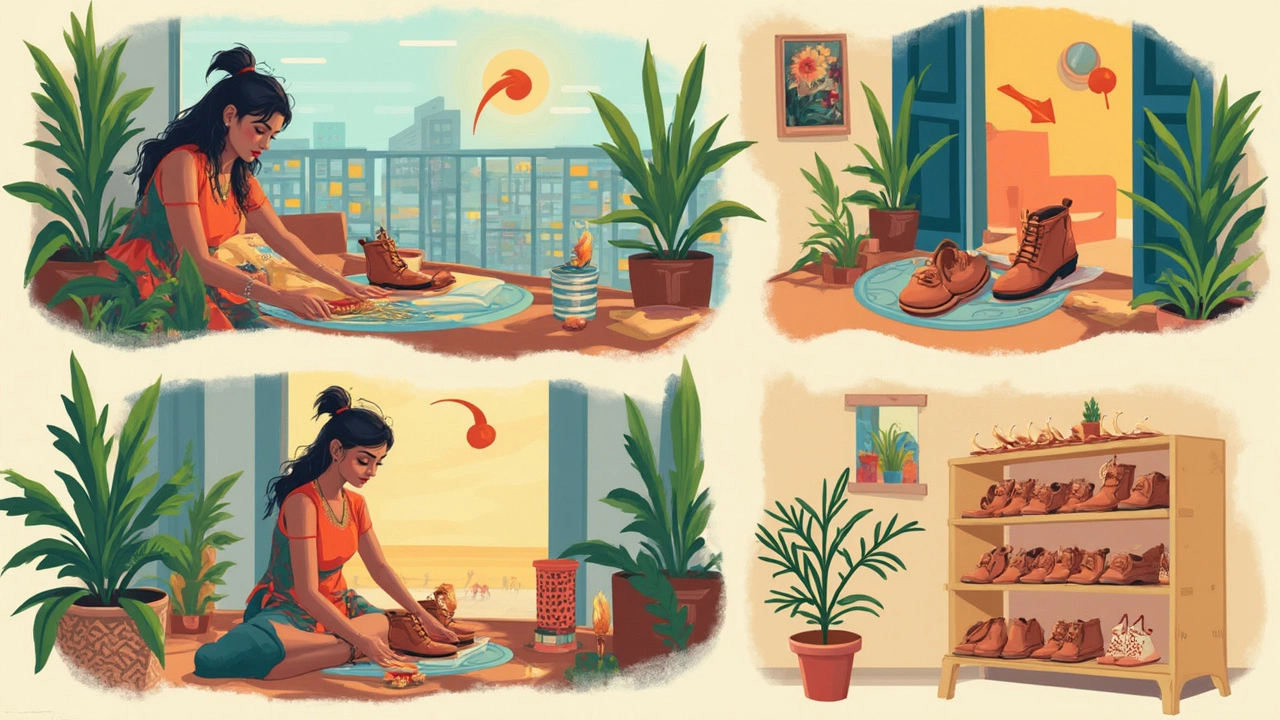Got a favorite pair of leather shoes you just want to keep wearing? I totally get it. But did you know wearing them two days in a row can actually ruin them faster? Here’s the deal—your feet sweat a lot more than you think (like, seriously, even if you don’t notice), and all that moisture soaks right into the leather.
When you wear the same pair every day, the leather barely gets a chance to dry out. This sets up the perfect playground for bacteria, smells, and even ugly creases. It’s kind of like never letting your bed sheets air out—just gross. Even my dog, Alfie, avoids his bed if it gets damp, and leather shoes are the same.
There’s actually a simple trick: give your shoes a day off. Letting them rest between wears helps keep that rich leather looking fresh and stops unpleasant odors from taking over. Sure, shoe trees help, but nothing beats straight-up time to dry. If you’re spending good money on decent shoes, you definitely want them to last. Read on and I’ll tell you what’s really going on inside your shoes every time you slip them on, and how you can make your investment go the distance.
- The Science of Leather and Moisture
- What Happens When You Skip a Day
- Common Myths People Believe
- Tips to Maximize Shoe Lifespan
- What to Do When You Can’t Rotate Shoes
The Science of Leather and Moisture
Let’s break down what actually happens with leather shoes and sweat. Leather is skin, just not living, and it’s naturally porous. These little pores are like tiny sponges—when your feet sweat, that moisture goes right in. A study from the College of Podiatry found your feet can put out up to half a pint of moisture a day, even if you’re just walking around the office. Kinda gross, but true.
Why should you care? If your leather shoes don’t fully dry out between wears, the leather never bounces back. Every new day you wear them, you’re adding fresh moisture before yesterday’s has left. Moisture trapped inside breaks down the structure of the leather, and that’s how shoes lose their shape and get that stale odor.
“Repeated exposure to moisture makes leather fibers swell, weaken, and eventually break down. That’s why proper drying between wears is essential for shoe longevity,” — The Leather Working Group.
Check out just how much your sweaty feet can affect your kicks:
| Activity | Average Moisture Produced (per day) |
|---|---|
| Sitting at a desk | ~200 ml |
| Walking/Commute | ~250 ml |
| Active (lots of standing) | ~300 ml |
That’s a lot of moisture for one pair to handle! Fresh air and time are your best friends here, because cramming all that sweat into just one pair day after day is like washing your clothes and wearing them damp—they get funky fast. Plus, damp leather is a magnet for bacteria and mold, which speed up the damage and make your shoes smell even worse.
Bottom line? Rotation isn’t just about style—it’s about real, science-backed shoe care. Don’t give in to shortcut habits if you want your shoes to stick around for the long haul.
What Happens When You Skip a Day
Giving your leather shoes time off is like giving your feet a break after a long hike. The moment you step out of your leather shoes, they start releasing all that built-up sweat and heat. Leather is more than just a fancy-looking material—it’s a natural skin that breathes, but only if you let it.
On a regular day, your feet can dump up to half a cup of moisture into your shoes. It sounds wild, but scientists have measured it. If you wear your shoes again the next day, the dampness hasn’t had time to fully escape, and everything inside—including the insoles and lining—stays moist. This is where things get rough for your shoes:
- The leather fibers get soft and lose structure. When you walk, this causes deep creasing and sometimes even cracking.
- Bacteria and fungi absolutely love moist, warm places. That muddy smell that never leaves? That’s your cue.
- The glue holding soles and linings together weakens faster, especially in hot or humid weather.
Here’s a quick look at what’s going on, based on real numbers:
| Action | Result After 24h Rest | Result Without Rest |
|---|---|---|
| Moisture release | 75-90% dried out | 45-60% dried out |
| Bacteria growth | Minimal | Rapid |
| Leather flexibility | Stays firm | Becomes soft, more likely to crease |
If you want your shoes to hold up and stop smelling like sweaty gym socks, a day off between wears makes all the difference. With regular drying, you’ll notice your shoes keep their shape, feel better, and even polish up easier. It’s a little habit that pays off big time—trust me, I learned after ruining my first good pair back in college. My advice? Treat them like you’d treat anything you want to keep in great shape—just let them breathe.

Common Myths People Believe
People talk a lot about taking care of leather shoes, but there’s plenty of bad advice floating around. Let’s break down a few popular myths that just don’t hold up when you look at the facts.
Leather shoes are not indestructible, and believing a few old wives’ tales can lead to serious wear and tear. Here’s what I hear all the time:
- Myth 1: "High-quality leather doesn’t need rest." Actually, even the best leather soaks up sweat and needs to dry out. No matter how much you spend, leather is porous, and it acts like a sponge for moisture.
- Myth 2: "A quick polish is enough care." Polishing just makes them shiny and maybe adds a protective layer. It doesn’t pull moisture out or fight off bacteria trapped inside the leather.
- Myth 3: "Odor in leather shoes is just about hygiene." Not really. Odor is mostly from bacteria having a party in all that damp leather. Letting your shoes dry properly is more important than scrubbing your feet.
- Myth 4: "Shoe trees can replace rest days." Shoe trees are great, but they only help keep the shape and absorb a bit of moisture. They’re not magic. Shoes still need a full day off to air out.
If you want proof, check out the numbers. Studies by the American Podiatric Medical Association have shown that your feet can produce up to half a pint of sweat per day! All that moisture has to go somewhere, and if you trap it in your shoes day after day, it leads to:
| Consequence | How Fast It Happens (Daily Wear) |
|---|---|
| Permanent creases/folds | Within months |
| Odor buildup | A couple of weeks |
| Leather cracking | 6–12 months |
| Lining breakdown | Under 1 year if always damp |
Bottom line: most myths come from wanting a shortcut, but leather shoes need downtime—just like you after a long work week. Don’t fall for the hype that you can wear them every day with no consequences. Rotate your pairs, and they’ll last way longer—and smell a whole lot better.
Tips to Maximize Shoe Lifespan
If you want your leather shoes to go the distance, a little care goes a long way. Let’s break down what actually works—not just old-school myths your grandpa might've told you.
First, always use shoe trees. These guys keep your shoes in shape and help soak up any sweat still hiding in the leather. Go for cedar ones—they naturally deodorize and absorb moisture better than cheap plastic ones.
- Rotate your shoes: Give each pair at least a full 24 hours to dry out before you wear them again. This simple step keeps leather from breaking down and stops that funky smell in its tracks.
- Use proper storage: Store your shoes somewhere cool and dry. Avoid tossing them in a pile or near radiators, which can cause cracking and warping.
- Clean them regularly: Wipe dirt off right away with a soft cloth. Every few weeks, use a cleaner made for leather, then finish with a conditioner so the leather doesn’t dry out.
- Polish smart: Polishing keeps leather looking sharp and adds a thin shield against dirt and water. But don’t overdo it—too much polish stacks up and actually weakens the shoe over time.
- Mind the weather: Leather hates heavy rain. If you get caught in a downpour, stuff your shoes with newspaper and let them air dry naturally—never use a hair dryer or stick them near a heater.
Here’s a quick look at the difference in lifespan between well-maintained and neglected leather shoes:
| Shoe Care Level | Average Lifespan (Years) |
|---|---|
| Properly Maintained (rotated, cleaned, conditioned) | 5 - 10 |
| Worn daily (no rotation), rarely cleaned | 1 - 2 |
Taking care of your shoes isn’t complicated, but it does need a routine. Invest a few minutes after each wear and you’ll get years more out of your shoes. Plus, it just feels good to know you’re getting your money’s worth every time you lace up.

What to Do When You Can’t Rotate Shoes
Let’s be real—not everyone can afford a closet full of shoes. Maybe work rules say you’ve got to wear the same style every day, or that one pair is your daily go-to. If you have to wear your leather shoes back-to-back, you don’t have to watch them fall apart right away. You just need to tweak your game a bit.
The main trouble comes down to moisture. Leather holds onto that sweat, and trapped dampness can mean stinky shoes and faster wear. But you can fight back with a few easy moves:
- Dry shoes overnight: The biggest thing you can do is let your shoes dry as much as possible. Don’t toss them in the closet right away—prop them up somewhere with airflow. If you’ve got a fan, use it. Just avoid direct heat (like radiators) because that’s a one-way ticket to cracked leather.
- Use cedar shoe trees: These little lifesavers pull out the damp and help your shoes keep their shape. Cedar also eats up that “did a gym bag die in here?” smell.
- Swap insoles: Pop them out after wearing. This makes them (and your shoes) dry faster and helps with that sweaty slide you sometimes feel.
- Ditch cotton socks: Cotton soaks up sweat and hangs onto it. Wool or synthetic socks actually wick it away, so your leather shoes don’t get as soggy in the first place.
- Give them a wipe: Quick wipe-down with a soft cloth after you wear them pulls off gunk and surface moisture before it sinks in.
If you’ve got a hairdryer, give your shoes a blast on the cool setting for a couple minutes. Definitely skip the hot air—it’s too risky for the leather.
Here’s how much difference simple steps can make. Check out this table showing how overnight drying and shoe trees affect moisture levels (measured by a shoe care study at a UK university):
| Method | Average Moisture Left After 8hrs |
|---|---|
| Shoe left in closed space | 41% |
| Shoe in open air | 17% |
| With cedar shoe tree | 10% |
| With fan (no shoe tree) | 7% |
So yeah, just switching up where you park your shoes overnight can make a big difference. Take a minute for a bit of care and your favorite pair will stick around way longer—even if you’ve got no choice but to wear them every single day.
